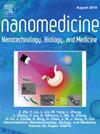Nanoparticle-infused wound dressings: A novel alternative to injectable therapies for enhanced healing and drug delivery
IF 4.6
2区 医学
Q2 MEDICINE, RESEARCH & EXPERIMENTAL
Nanomedicine : nanotechnology, biology, and medicine
Pub Date : 2025-08-19
DOI:10.1016/j.nano.2025.102852
引用次数: 0
Abstract
Chronic and acute wounds pose significant challenges in healthcare, often requiring prolonged treatment and frequent interventions. Traditional injectable drug therapies, while effective, have limitations such as systemic side effects, low patient compliance, and inefficient drug delivery to the wound site. Nanoparticle-infused wound dressings offer a promising alternative by providing localized, sustained drug release while enhancing the wound healing process. These advanced dressings integrate nanoparticles (NPs) such as metallic, polymeric, lipid-based, and hydrogel-based systems to improve antimicrobial activity, promote angiogenesis, and facilitate tissue regeneration. Nanoparticles enable controlled drug release, protect bioactive agents from degradation, and enhance penetration into deeper wound layers, making them highly effective for chronic wounds like diabetic ulcers, burns, and surgical incisions. Moreover, functionalized NPs can incorporate antimicrobial agents, growth factors, and anti-inflammatory compounds, significantly reducing infection risks and promoting faster healing. Emerging studies highlight the potential of silver, gold, chitosan, and lipid-based NPs in improving wound care outcomes compared to conventional approaches. This review provides a comprehensive analysis of various nanoparticle-based wound dressings, their mechanisms of action, and their advantages over injectable therapies. It also discusses the challenges in clinical translation, including biocompatibility, regulatory hurdles, and large-scale production. With continuous advancements in nanomedicine, nanoparticle-infused wound dressings hold immense potential to revolutionize wound management, offering a patient-friendly and efficient alternative to traditional treatments. Future research should focus on optimizing formulations, ensuring safety, and conducting large-scale clinical trials to facilitate their transition into mainstream medical practice.

纳米颗粒注入伤口敷料:一种新的替代注射疗法,以增强愈合和药物输送
慢性和急性伤口对医疗保健构成重大挑战,往往需要长期治疗和频繁干预。传统的注射药物治疗虽然有效,但也有局限性,如全身副作用、患者依从性低、给药效率低。纳米颗粒注入伤口敷料提供了一个有前途的替代方案,提供局部,持续的药物释放,同时促进伤口愈合过程。这些先进的敷料集成了纳米颗粒(NPs),如金属、聚合物、脂质和水凝胶系统,以提高抗菌活性,促进血管生成,促进组织再生。纳米颗粒能够控制药物释放,保护生物活性药物不被降解,并增强对伤口深层的渗透,使其对慢性伤口如糖尿病溃疡、烧伤和手术切口非常有效。此外,功能化的NPs可以结合抗菌药物、生长因子和抗炎化合物,显著降低感染风险并促进更快的愈合。与传统方法相比,新兴研究强调了银、金、壳聚糖和脂质NPs在改善伤口护理结果方面的潜力。这篇综述提供了各种基于纳米颗粒的伤口敷料,它们的作用机制,以及它们相对于注射治疗的优势的综合分析。它还讨论了临床翻译的挑战,包括生物相容性,监管障碍和大规模生产。随着纳米医学的不断进步,注入纳米颗粒的伤口敷料具有巨大的潜力,可以彻底改变伤口管理,为患者提供一种友好和有效的替代传统治疗方法。未来的研究应侧重于优化配方,确保安全性,并进行大规模临床试验,以促进其过渡到主流医疗实践。
本文章由计算机程序翻译,如有差异,请以英文原文为准。
求助全文
约1分钟内获得全文
求助全文
来源期刊
CiteScore
11.10
自引率
0.00%
发文量
133
审稿时长
42 days
期刊介绍:
The mission of Nanomedicine: Nanotechnology, Biology, and Medicine (Nanomedicine: NBM) is to promote the emerging interdisciplinary field of nanomedicine.
Nanomedicine: NBM is an international, peer-reviewed journal presenting novel, significant, and interdisciplinary theoretical and experimental results related to nanoscience and nanotechnology in the life and health sciences. Content includes basic, translational, and clinical research addressing diagnosis, treatment, monitoring, prediction, and prevention of diseases.

 求助内容:
求助内容: 应助结果提醒方式:
应助结果提醒方式:


